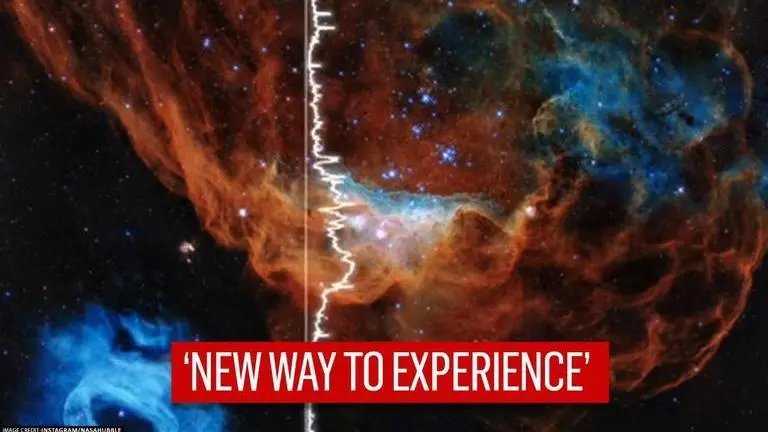Updated 20 October 2020 at 16:06 IST
NASA reveals how space’s ‘Cosmic Reef’ sounds like as Hubble marks 30th anniversary
NASA explained in the caption alongside the sonification that there red part depicted the presence of hydrogen and nitrogen, and the blue indicated oxygen.
- Science News
- 2 min read

NASA’s recent footage of data sonification of space’s ‘Cosmic Reef’ on the occasion of Hubble’s 30th anniversary has left the internet mesmerized. The space agency converted a space portrait of a firestorm of star birth in a neighbouring galaxy 163,000 light-years away into a pattern of the sound of varying pitches. Sharing the image of two nebulae, giant red nebula (NGC 2014), and its smaller blue neighbor (NGC 2020), which are a part of the Large Magellanic Cloud, NASA asked astrophiles on Instagram if they ever wondered “What does the Cosmic Reef ‘sound’ like?”
NASA translated Hubble Telescope’s iconic digital imagery into a sound that began the left side from the smaller blue neighbour of the image and gradually moved rightward to the red cosmic nebula. NASA explained in the caption alongside the sonification that there red part depicted the presence of hydrogen and nitrogen, and the blue indicated oxygen. The higher pitches were assigned to the NGC 2020 while the lower pitches were formulated on the NGC 2014. “There’s no sound in space, but sonification let us conceptualize the information in images with our ears,” NASA wrote on alongside Hubble’s imagery of Nebulae that resembled the undersea.
Advertisement
Nebulae resembles coral reef in seas
According to NASA, Hubble’s image is nicknamed as the "Cosmic Reef," because NGC 2014 resembles part of a coral reef floating in a vast sea of stars which are gigantic. “The nebula's sparkling centerpiece is a grouping of bright, hefty stars, each 10 to 20 times more massive than our Sun,” NASA informed in a release. Further, it explained that the isolated blue nebula at point where the lower pitch is recorded is created out of the solitary mammoth star which is approximately 200,000 times brighter than the sun. Some eruptive events in the outer envelope of NGC 2020 caused the blue gas to ooze out of the stars.
Speaking about the spectacular Cosmic Reef captured by Hubble, associate administrator for science at NASA Headquarters in Washington, D.C said that it was NASA’s revolutionary launch that such a large telescope was sent into space some 30 years ago, and this astronomy powerhouse is still delivering revolutionary science today. Due to the crystal-clear sharpness of the range of wavelengths of its ultraviolet to near-infrared lights, the Cosmic Reef can be heard producing distinct iconic sounds.
Advertisement
Published By : Zaini Majeed
Published On: 20 October 2020 at 16:07 IST



